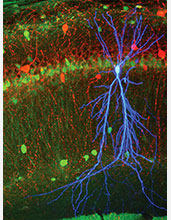Multimedia Gallery
Studying memory's ripples
A stained pyramidal cell (shown in blue) in area CA1--a part of the hippocampus that is thought to be an important relay station for memories--of the mouse hippocampus. Neurons expressing calbindin are shown in green and inhibitory neurons expressing parvalbumin are shown in red. During intracellular recording of the neuron’s membrane potential, the pyramidal cell was filled with dye so it could be located and imaged.
More about this image
Neuroscientists at Caltech have looked inside brain cells as they undergo intense bursts of neural activity known as "ripples" that are thought to underlie memory formation. During ripples, a small fraction of brain cells, or neurons, fire synchronously in area CA1, a part of the hippocampus that is thought to be an important relay station for memories.
How do ripples exert their influence on the rest of the brain? The membrane potential of each neuron oscillates very rapidly during ripples to synchronize the firing of cells to within a few thousandths of a second. "By coordinating their activities, the CA1 neurons are maximizing the impact of their output on downstream areas of the brain. The overall effect is more powerful than if each neuron fired independently," says Lubenov, a coauthor of the study and a research scientist at Caltech. "It is the difference between clapping independently or in unison with others at a concert. The effect in the latter case is stronger, even with the same number of people applauding."
To learn more about this research, see the Caltech news story Studying memory's 'ripples'. (Date image taken: 2015-2016; date originally posted to NSF Multimedia Gallery: May 31, 2017)
Credit: Image courtesy of T. Siapas/Caltech
Images and other media in the National Science Foundation Multimedia Gallery are available for use in print and electronic material by NSF employees, members of the media, university staff, teachers and the general public. All media in the gallery are intended for personal, educational and nonprofit/non-commercial use only.
Images credited to the National Science Foundation, a federal agency, are in the public domain. The images were created by employees of the United States Government as part of their official duties or prepared by contractors as "works for hire" for NSF. You may freely use NSF-credited images and, at your discretion, credit NSF with a "Courtesy: National Science Foundation" notation.
Additional information about general usage can be found in Conditions.
Also Available:
Download the high-resolution JPG version of the image. (987.8 KB)
Use your mouse to right-click (Mac users may need to Ctrl-click) the link above and choose the option that will save the file or target to your computer.

